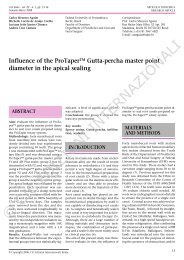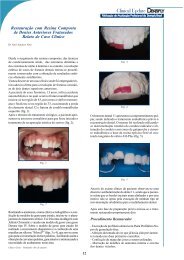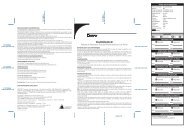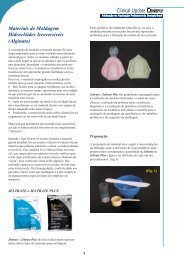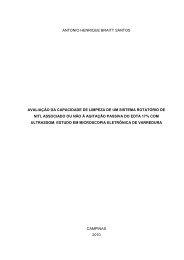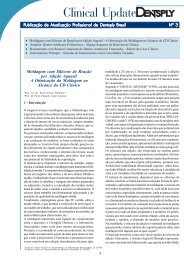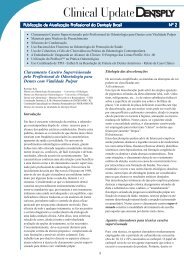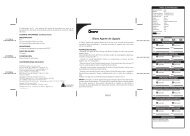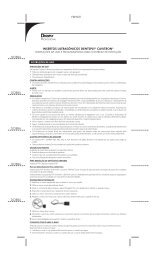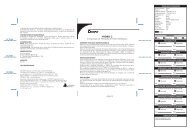Create successful ePaper yourself
Turn your PDF publications into a flip-book with our unique Google optimized e-Paper software.
Braem<br />
the number of steps but also the degree of difficulty of the<br />
step appears to be of primary importance.<br />
The present results indicate that the fatigue behavior of<br />
each individual adhesive must be carefully studied, since<br />
within each group results can be found that outperform<br />
and/or are similar to results obtained by particular adhesives<br />
in other groups. This indicates that, in general, the different<br />
types of bonding approaches converge to adequate<br />
results. In this context, the result for the glass-ionomer cement<br />
is surprising: both the microshear bond strength and<br />
the μSFR are among the lowest measured in this study. This<br />
can be explained by a mismatch in the mechanical properties<br />
of the glass-ionomer matrix and the glass particles,<br />
causing large stresses to accumulate at their interface. 11<br />
However, the clinical performance of these materials under<br />
the right indications is still remarkably good, thus supporting<br />
the hypothesis that “self-healing” or “repair” might be<br />
possible in glass-ionomer cements, 3 although such “healing”<br />
may rather be retardation in crack growth or a crack<br />
growth toughening mechanism due to the plasticizing effect<br />
of the resinous component.<br />
CONCLUSION<br />
Tooth/adhesive interfaces suffer from the progressive damage<br />
induced by subcritical cyclic loads. The differing approaches<br />
to achieving tooth-resin bonding are not consistently<br />
reflected in differences in fatigue resistance.<br />
ACKNOWLEDGMENTS<br />
The author thanks the manufacturers for the generous donation of materials.<br />
Thanks also to Dr. Jan De Munck, Leuven BIOMAT Research<br />
Cluster K.U. Leuven, Belgium, the statistical analysis could be performed.<br />
Finally, the supporting efforts and constructive criticism of Mr.<br />
Geert Keteleer, Lab Dental Materials – Universiteit Antwerpen, are<br />
greatly acknowledged.<br />
This research was partly sponsored by <strong>Dentsply</strong> DeTrey, Konstanz,<br />
Germany.<br />
REFERENCES<br />
1. Baran GR, Boberick KG, McCool JI. Fatigue of restorative materials. Crit<br />
Rev Oral Biol Med 2001;12:350-360.<br />
2. Braem M, Davidson CL, Lambrechts P, Vanherle G. In vitro flexural fatigue<br />
limits of dental composites. J Biomed Mater Res 1994;28:1397-1402.<br />
3. Davidson CL. Glassionomer bases under posterior composites. J Esthet<br />
Dent 1994;6:223-226.<br />
4. De Munck J, Braem M, Wevers M, Yoshida Y, Inoue S, Suzuki K, Lambrechts<br />
P, Van Meerbeek B. Micro-rotary fatigue of tooth-biomaterial interfaces.<br />
Biomater 2005;26:1145-1153.<br />
5. Dewji HR, Drummond JL, FadaviS, Punwani I. Bond strength of bis-GMA<br />
and glass ionomer pit and fissure sealants using cyclic fatigue. Eur J Oral<br />
Sci 1998;6:594-599.<br />
6. Draughn RA. Compressive fatigue limits of composite restorative materials.<br />
J Dent Res 1979;58:1093-1096.<br />
7. Givan DA, Fitchie JG, Anderson L, Zardiackas LD. Tensile fatigue of 4-META<br />
cement bonding three base metal alloys to enamel and comparison to<br />
other resin cements. J Prosthet Dent 1995;73:377-385.<br />
8. Hawbolt EB, MacEntee MI. Effects of fatigue on a soldered base metal<br />
alloy. J Dent Res 1983;62:1226-1228.<br />
9. Huysmans MCDNJM, Van der Varst PGT, Schäfer R, Peters MCRB, Plasschaert<br />
AJM, Soltész U. Fatigue behavior of direct post-and-core-restored<br />
premolars. J Dent Res 1992;71:1145-1150.<br />
10. McCabe JF, Carrick TE, Chadwick RG, Walls AWG. Alternative approaches<br />
to evaluating the fatigue characteristics of materials. Dent Mater<br />
1990;6:24-28.<br />
11. Nakajima H, Watkins JH, Arita K, Hanaoka K, Okabe T. Mechanical properties<br />
of glass ionomers under static and dynamic loading. Dent Mater<br />
1996;12:30-37.<br />
12. Nikaido T, Kunzelmann K-H, Chen H, Ogata M, Harada A, Yamaguchi Y, Cox<br />
CF, Hickel R, Tagami J. Evaluation of thermal cycling and mechanical loading<br />
on bond strength of a self-etching primer system to dentin. Dent Mater<br />
2002;18:269-275.<br />
13. Ruse ND, Shew R, Feduik D. In vitro fatigue testing of a dental bonding system<br />
on enamel. J Biomed Mater Res 1995;29:411-415.<br />
14. Wiskott HWA, Nicholls JI, Belser UC. Fatigue resistance of soldered joints:<br />
A methodological study. Dent Mater 1994;10:215-220.<br />
Clinical relevance: Repetitive shear loading off freshly<br />
placed adhesive fillings will impose subcritical loads<br />
that could finally induce damage and/or loss of the adhesion.<br />
The study of such behavior is therefore of utmost<br />
importance in order to gain knowledge on this<br />
type of failure<br />
Vol 9, Supplement 2, 2007 253



